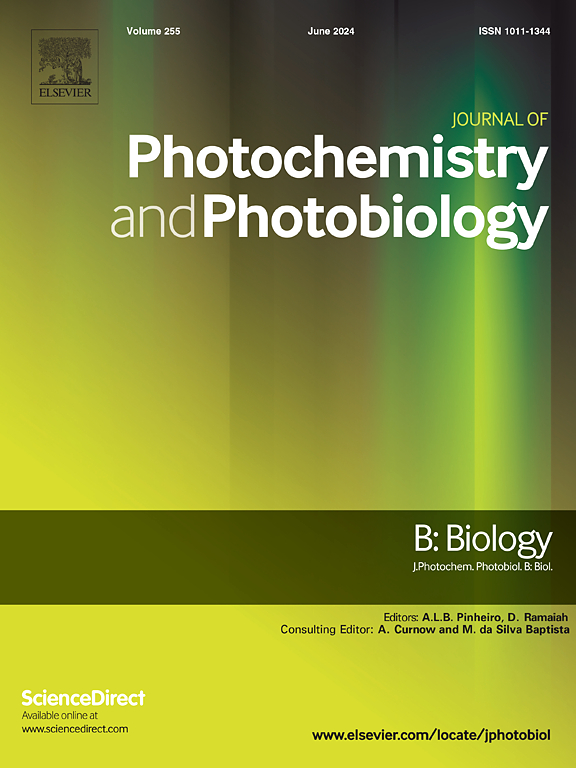A comparative theoretical study on the photoisomerization and antioxidant capacity of resveratrol and its Azo/Dihydro analogs
IF 3.7
2区 生物学
Q2 BIOCHEMISTRY & MOLECULAR BIOLOGY
Journal of photochemistry and photobiology. B, Biology
Pub Date : 2025-09-01
DOI:10.1016/j.jphotobiol.2025.113251
引用次数: 0
Abstract
This study employs a suite of quantum chemical methods to systematically investigate the photoisomerization mechanism and antioxidant activity of resveratrol (Res) and two key derivatives, Azo-Resveratrol (AzoRes) and Dihydro-Resveratrol (dhRes), thereby elucidating the impact of molecular scaffold modification on their structure-activity relationships. Employing density functional theory (DFT), time-dependent DFT (TD-DFT), spin-flip TD-DFT and multistate complete active space second-order perturbation theory (MS-CASPT2), we investigated the geometric configurations, absorption spectra, photoisomerization pathways, and key antioxidant parameters for all three molecules. The results reveal that the substitution of the C![]() C bond with an N
C bond with an N![]() N linkage (AzoRes) induces a bathochromic shift in the absorption spectrum, introduces a low-energy n → π* transition, and facilitates a barrierless photoisomerization pathway. Conversely, the saturation of the C
N linkage (AzoRes) induces a bathochromic shift in the absorption spectrum, introduces a low-energy n → π* transition, and facilitates a barrierless photoisomerization pathway. Conversely, the saturation of the C![]() C bond to a C
C bond to a C![]() C single bond (dhRes) disrupts the π-conjugated system, resulting in a significant hypsochromic shift. Analysis of frontier molecular orbitals and global descriptive parameters established the order of S0-state antioxidant capacity as AzoRes > Res > dhRes, a trend that correlates with the narrower HOMO-LUMO gap of AzoRes compared to Res (by 0.302 eV and 0.564 eV for trans and cis isomers, respectively). While photoexcitation universally enhanced the antioxidant potential of all molecules, it also reordered the efficacy to Res > AzoRes > DHRes in the S1 state. Our findings elucidate the intrinsic relationship between the molecular scaffold, photochemical behavior, and antioxidant activity, providing a theoretical framework for the rational design of novel photo-responsive antioxidant materials.
C single bond (dhRes) disrupts the π-conjugated system, resulting in a significant hypsochromic shift. Analysis of frontier molecular orbitals and global descriptive parameters established the order of S0-state antioxidant capacity as AzoRes > Res > dhRes, a trend that correlates with the narrower HOMO-LUMO gap of AzoRes compared to Res (by 0.302 eV and 0.564 eV for trans and cis isomers, respectively). While photoexcitation universally enhanced the antioxidant potential of all molecules, it also reordered the efficacy to Res > AzoRes > DHRes in the S1 state. Our findings elucidate the intrinsic relationship between the molecular scaffold, photochemical behavior, and antioxidant activity, providing a theoretical framework for the rational design of novel photo-responsive antioxidant materials.

白藜芦醇及其偶氮/双氢类似物的光异构化和抗氧化能力的比较理论研究
本研究采用一套量子化学方法,系统研究了白藜芦醇(Res)及其两个关键衍生物偶氮白藜芦醇(AzoRes)和二氢白藜芦醇(dhRes)的光异构化机理和抗氧化活性,从而阐明分子支架修饰对其构效关系的影响。利用密度泛函理论(DFT)、时变DFT (TD-DFT)、自旋翻转TD-DFT和多态完全活性空间二阶微扰理论(MS-CASPT2),研究了这三种分子的几何构型、吸收光谱、光异构化途径和关键抗氧化参数。结果表明,用NN键(AzoRes)取代CC键引起了吸收光谱的色移,引入了低能n→π*跃迁,促进了无障碍光异构化途径。相反,CC键饱和成CC单键(dhRes)会破坏π共轭体系,导致明显的次色移。前沿分子轨道和全局描述参数的分析确定了50态抗氧化能力的顺序为AzoRes >; Res > dhRes,这一趋势与AzoRes的HOMO-LUMO差距比Res小(反式和顺式异构体分别为0.302 eV和0.564 eV)有关。虽然光激发普遍增强了所有分子的抗氧化能力,但它也将作用重新排序到S1态的Res >; AzoRes > DHRes。我们的研究结果阐明了分子支架、光化学行为和抗氧化活性之间的内在关系,为合理设计新型光响应抗氧化材料提供了理论框架。
本文章由计算机程序翻译,如有差异,请以英文原文为准。
求助全文
约1分钟内获得全文
求助全文
来源期刊
CiteScore
12.10
自引率
1.90%
发文量
161
审稿时长
37 days
期刊介绍:
The Journal of Photochemistry and Photobiology B: Biology provides a forum for the publication of papers relating to the various aspects of photobiology, as well as a means for communication in this multidisciplinary field.
The scope includes:
- Bioluminescence
- Chronobiology
- DNA repair
- Environmental photobiology
- Nanotechnology in photobiology
- Photocarcinogenesis
- Photochemistry of biomolecules
- Photodynamic therapy
- Photomedicine
- Photomorphogenesis
- Photomovement
- Photoreception
- Photosensitization
- Photosynthesis
- Phototechnology
- Spectroscopy of biological systems
- UV and visible radiation effects and vision.

 求助内容:
求助内容: 应助结果提醒方式:
应助结果提醒方式:


